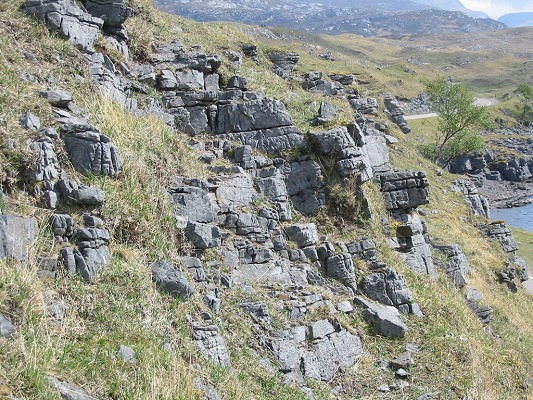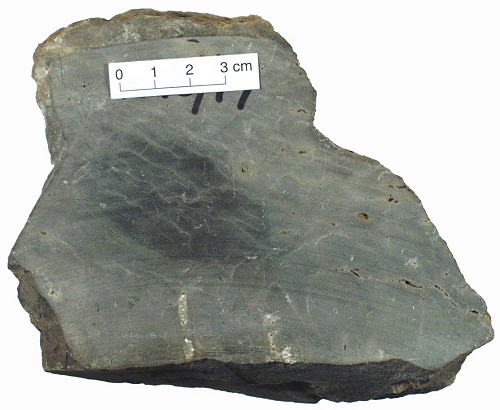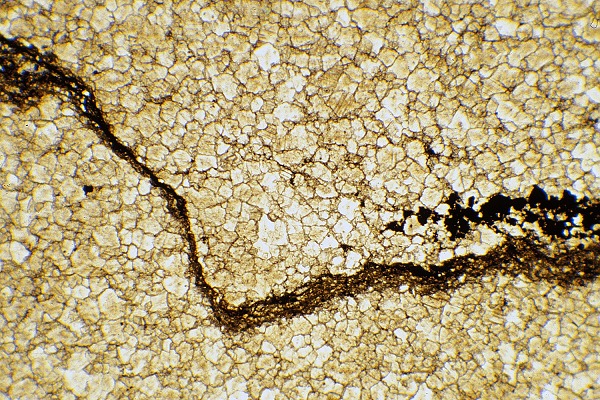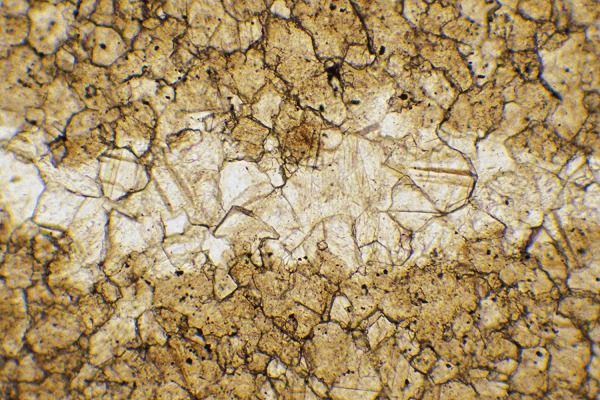
| Home | Geological History | Stratigraphy | Area map | Rock Index | About |
| Scourie | Achmelvich | Laxford | Clachtoll | Stoer | Assynt | Skiag Bridge | Glencoul | Knockan | Borralan | Ledmore |
From road-cuts near Skiag Bridge, Loch Assynt

![]() Grey
dolomitic limestone; Cambrian Durness Limestone, Loch
Assynt
Grey
dolomitic limestone; Cambrian Durness Limestone, Loch
Assynt
This exposure lies just above the road, and shows the
typical appearance of a weathered outcrop of the grey
Durness Limestone. It is a grey dolomite, fine-grained and
bedded in units 10 to 20 cm thick. Lichens do not grow on
the rock surface, and the lime-rich soil discourages the
growth of heather. Instead, areas underlain by the
limestone are grassy, with a variety of lime-loving wild
flowers. Rainwater slowly dissolves the surface of the
outcrop, eating into the bedding planes to make the
layering stand out more strongly, and etching out small
vertical fractures into deeper grooves.

![]() Grey
dolomitic limestone; Cambrian Durness Limestone, Loch
Assynt
Grey
dolomitic limestone; Cambrian Durness Limestone, Loch
Assynt
The cut surface of the limestone is dull grey, revealing
few features. No bedding is visible at this scale, but tiny
pale veinlets trace wavy paths across the surface in at
least two directions. Fine limestones commonly fracture,
and solutions passing through the cracks fill them up with
more carbonate, precipitated from solution.

![]() Grey dolomitic limestone; Cambrian Durness
Limestone, Loch Assynt
Grey dolomitic limestone; Cambrian Durness
Limestone, Loch Assynt
The Durness Limestone is mostly formed from carbonate mud,
and is made of fine-grained interlocking dolomite crystals.
Bedding is not usually visible. However, there are
irregular seams of dark material traversing the rock, like
that shown in this view. These probably form when the rock
is put under pressure and compacted: the carbonate, being
slightly soluble, gets preferentially dissolved along
certain layers, leaving the dark non-carbonate material
behind in a concentrated mass.
Plane polarized light, field of view 2.5 mm across.

![]() Grey dolomitic limestone; Cambrian Durness
Limestone, Loch Assynt
Grey dolomitic limestone; Cambrian Durness
Limestone, Loch Assynt
This view shows one of the pale veinlets in detail.
Compaction of the rock compresses it in some directions but
opens up tiny fractures in others. The fractures fill with
more carbonate crystals, but these new ones are free of the
tiny grains of opaque matter that give the rock its grey
colour. In thin section the vein material is clear, and the
host rock is clouded with opaque dust.
Plane polarized light, field of view 1 mm across.
| Scourie | Achmelvich | Laxford | Clachtoll | Stoer | Assynt | Skiag Bridge | Glencoul | Knockan | Borralan | Ledmore |
| Home | Geological History | Stratigraphy | Area map | Rock Index | About |
D.J. Waters, Department of Earth Sciences, May 2003